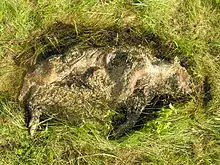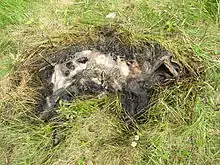Corpse decomposition
Decomposition is the process in which the organs and complex molecules of a human body break down into simple organic matter over time. In vertebrates, five stages of decomposition are typically recognized: fresh, bloat, active decay, advanced decay, and dry/skeletonized.[1] The rate of decomposition of human remains can vary due to environmental factors such as temperature, humidity and the availability of oxygen, as well as body size, clothing and the cause of death.[2]
Stages and characteristics
The five stages of decomposition—fresh (aka autolysis), bloat, active decay, advanced decay, and dry/skeletonized—have specific characteristics that are used to identify which stage the remains are in.[3] These stages are illustrated by reference to an experimental study of the decay of a pig corpse.[1]
Fresh

At this stage the remains are usually intact and free of insects. The corpse progresses through algor mortis (a reduction in body temperature until ambient temperature is reached), rigor mortis (the temporary stiffening of the limbs due to chemical changes in the muscles), and livor mortis (pooling of the blood on the side of the body that is closer to the ground).[4]
Bloat

At this stage, the microorganisms residing in the human gut begin to digest the tissues of the body, excreting gases that cause the torso and limbs to bloat, and producing foul-smelling chemicals including putrescine and cadaverine.[5] Cells in tissues break down and release hydrolytic enzymes, and the top layer of skin may become loosened, leading to skin slippage.[6]:153–162 Decomposition of the gastrointestinal tract results in a dark, foul-smelling liquid called "purge fluid" that is forced out of the nose and mouth due to gas pressure in the intestine.[6]:155 The bloat stage is characterized by a shift in the bacterial population from aerobic to anaerobic bacterial species.[7]
Active decay

At this stage, the tissues begin to liquefy and the skin will start to blacken. Blowflies target decomposing corpses early on, using specialized smell receptors, and lay their eggs in orifices and open wounds.[7] The size and development stage of maggots can be used to give a measure of the minimum time since death.[8]:251–252 Insect activity occurs in a series of waves, and identifying the insects present can give additional information on the postmortem interval.[9] Adipocere, or corpse wax, may be formed, inhibiting further decomposition.[8]:16–18
Advanced decay
During advanced decay, most of the remains have discolored and often blackened. Putrefaction, in which tissues and cells break down and liquidize as the body decays, will be almost complete.[1] A decomposing human body in the earth will eventually release 32g of nitrogen, 10g of phosphorus, 4g of potassium, and 1g of magnesium for every kilogram of dry body mass, making changes in the chemistry of the soil around it that may persist for years.[7]

Dry/skeletonized remains
Once bloating has ceased, the soft tissue of remains typically collapses in on itself. At the end of active decay, the remains are often dried out and begin to skeletonize.[1]

Effect of environmental conditions
Experimental analysis of decomposition on corpse farms
Corpse farms are used to study the decay of the human body and to gain insight into how environmental and endogenous factors affect progression through the stages of decomposition.[7] In summer, high temperatures can accelerate the stages of decomposition: heat encourages the breakdown of organic material, and bacteria also grow faster in a warm environment, accelerating bacterial digestion of tissue. However, natural mummification, normally thought of as a consequence of arid conditions, can occur if the remains are exposed to intense sunlight.[10] In winter, not all bodies go through the bloat stage. Bacterial growth is much reduced at temperatures below 4 °C.[11] Corpse farms are also used to study the interactions of insects with decaying bodies.[7]
Burial
Burial retards the rate of decomposition, in part because even a few inches of soil covering the corpse will prevent blowflies from laying their eggs on the corpse. The depth of burial, the nature of the soil, and the temperature and moisture content of the soil all affect decay.[8]:22–23
Wet environments
Submersion in water typically slows decomposition. The rate of loss of heat is higher in water and the progression through algor mortis is therefore faster. Cool temperatures slow bacterial growth. Once bloat begins, the body will typically float to the surface and become exposed to flies. Scavengers in the water, which vary with the location, also contribute to decay.[12] Factors affecting decomposition include water depth, temperature, tides, currents, seasons, dissolved oxygen, geology, acidity, salinity, sedimentation, and insect and scavenging activity.[13] Human remains found in aquatic surroundings are often incomplete and poorly preserved, making investigating the circumstances of death much more difficult.[14]
See also
- Raising of Lazarus, whose tomb is opened four days after burial
References
- Payne, Jerry A. (September 1965). "A Summer Carrion Study of the Baby Pig Sus Scrofa Linnaeus". Ecology. 46 (5): 592–602. doi:10.2307/1934999. ISSN 0012-9658. JSTOR 1934999.
- Vij, Krishan (2008). Textbook of Forensic Medicine And Toxicology: Principles And Practice (4th edition). Elsevier. pp. 126–128. ISBN 978-81-312-1129-8.
- Mądra A, Frątczak K, Grzywacz A, Matuszewski S (July 2015). "Long-term study of pig carrion entomofauna". Forensic Science International. 252: 1–10. doi:10.1016/j.forsciint.2015.04.013. PMID 25933423.
- Cerminara, Kathy L. (April 2011). "After We Die". Journal of Legal Medicine. 32 (2): 239–244. doi:10.1080/01947648.2011.576635. ISSN 0194-7648.
- Paczkowski S, Schütz S (August 2011). "Post-mortem volatiles of vertebrate tissue". Applied Microbiology and Biotechnology. 91 (4): 917–35. doi:10.1007/s00253-011-3417-x. PMC 3145088. PMID 21720824.
- Sorg, Marcella H.; Haglund, William D. (1996). Forensic Taphonomy: The Postmortem Fate of Human Remains. CRC Press. ISBN 9781439821923.
- Costandi, Mo (2015-05-05). "Life after death: the science of human decomposition". The Guardian. ISSN 0261-3077. Retrieved 2019-07-14.
- Gunn, Alan (2019). Essential Forensic Biology. John Wiley & Sons. ISBN 9781119141402.
- Byrd, Jason H. (2009). Forensic Entomology: The Utility of Arthropods in Legal Investigations, Second Edition. CRC Press. pp. 256–261. ISBN 9781420008869.
- Blakinger, Keri (2018-02-23). "Learning about decomposition at the body farm in San Marcos - HoustonChronicle.com". www.houstonchronicle.com. Retrieved 2019-07-14.
- Cockle DL, Bell LS (March 2017). "The environmental variables that impact human decomposition in terrestrially exposed contexts within Canada". Science & Justice. 57 (2): 107–117. doi:10.1016/j.scijus.2016.11.001. PMID 28284436.
- Gennard, Dorothy (2012). "Chapter 12: Investigations in an Aquatic Environment". Forensic Entomology: An Introduction. Oxford, UK: John Wiley & Sons. ISBN 9781119945802.
- Heaton, Vivienne; Lagden, Abigail; Moffatt, Colin; Simmons, Tal (March 2010). "Predicting the Postmortem Submersion Interval for Human Remains Recovered from U.K. Waterways". Journal of Forensic Sciences. 55 (2): 302–307. doi:10.1111/j.1556-4029.2009.01291.x. PMID 20102465.
- Delabarde, Tania; Keyser, Christine; Tracqui, Antoine; Charabidze, Damien; Ludes, Bertrand (May 2013). "The potential of forensic analysis on human bones found in riverine environment". Forensic Science International. 228 (1–3): e1–e5. doi:10.1016/j.forsciint.2013.03.019. PMID 23562147.